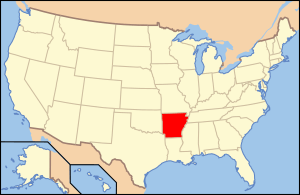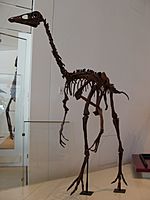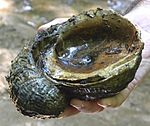Paleontology in Arkansas facts for kids

Fossils in Arkansas are found by scientists who study ancient life. This study is called paleontology. Arkansas has a rich history of fossils, from the Ordovician period all the way to the Eocene epoch. Most of the fossils found here are from ancient sea creatures without backbones, called invertebrates.
Millions of years ago, during the early Paleozoic Era, much of Arkansas was covered by a warm sea. This sea was home to many creatures, including Archimedes (a type of bryozoan), brachiopods (shellfish), and tiny, eel-like creatures called conodonts. The sea started to shrink during the Carboniferous period. By the Permian period, the entire state was dry land.
Land conditions continued into the Triassic period. But during the Jurassic period, another sea covered the southern part of the state. During the Cretaceous period, Arkansas was still mostly underwater. It was home to marine invertebrates like Belemnitella (a squid-like animal). On land, long-necked sauropod dinosaurs roamed, leaving their footprints behind. Ostrich-like dinosaurs, such as Arkansaurus, also lived here.
During the Cenozoic Era, the seas in Arkansas slowly disappeared. They were home to marine invertebrates and sharks. Later, during the Ice Age, Arkansas became much colder. Large grasslands and forests grew, where huge animals like mammoths, mastodons, and giant ground sloths lived.
Contents
Arkansas's Ancient Past
No fossils from the Precambrian era have been found in Arkansas. So, the state's fossil story begins in the Paleozoic Era. During this time, northern, central, and western Arkansas were covered by sea.
Life in Ancient Seas
In the Ordovician period, many different kinds of life lived in what is now Arkansas. Their remains turned into fossils in areas like East Lafferty Creek and Cushman in Independence County. The Silurian period also had a wide variety of life. Fossils from this time are also found near Cushman. Later, in the Devonian period, conodonts and Sporangites were preserved at Caddo Gap in Montgomery County.
During the Carboniferous period, Arkansas was home to Archimedes and many types of brachiopods. These fossils are found in places like West Fork and Fayetteville in Washington County. The Habberton area also has many invertebrate fossils from this time. In the early Carboniferous, called the Mississippian, Arkansas had many marine invertebrates. Later in the period, the northern part of the state became dry land as the sea pulled back. Rivers flowed across this area. In the Pennsylvanian part of the Carboniferous, Arkansas had star-shaped creatures called blastoids, like Pentremites. It also had brachiopods like Composita and Spirifer, and other invertebrates. The sea was completely gone by the start of the Permian period.
Northern and central Arkansas were dry land during the Triassic period. But by the early Jurassic period, seawater covered the southern part of the state again. This sea also covered southern and northeastern Arkansas into the Cretaceous period. Many fossils were left behind from the life that lived there.
During the Early Cretaceous, the area southeast of the Ouachita Mountains was covered by the Gulf of Mexico. The invertebrates in Arkansas's Cretaceous sea included clams, sea urchins, oysters, and snails. During the Cretaceous, Arkansas was home to Belemnitella, Exogyra, Ostrea, Turritella, and other marine invertebrates. These are found in the Arkadelphia area of Clark County. Fish from the same time left their teeth near Saratoga in Hempstead County. Other fossils there are similar to those found near Arkadelphia. Arkansas was also home to the sea turtle Bothremys, which might have eaten ancient snails. During the Late Cretaceous, the area of the Ouachita Mountains may have attracted long-necked plesiosaurs from far away. They came to find gastroliths (stomach stones). Sharks also lived in these waters.
Dinosaurs and Other Land Animals
Southwestern Arkansas was part of the coastline of the Western Interior Seaway during the Cretaceous period. Dinosaurs walked along these ancient shores, sometimes alone and sometimes in groups. Many footprints left by coastal sauropods (long-necked dinosaurs) have been preserved in the southwestern part of the state. The ostrich-like dinosaur Arkansaurus fridayi lived at this time. We only know about it from its foot bones, found in 1972.
The Ice Age and Beyond
The seas in southern and eastern Arkansas began to shrink during the early Cenozoic Era. Sharks and oysters were still present in these waters. During the Eocene epoch, Arkansas had marine invertebrates like echinoderms, Ostrea, and Turritella. The echinoderm fossils are found near Bradford in Jackson County. Ostrea fossils are found in Bradford and near Forrest City in St. Francis County. Turritella fossils are also found in Bradford. The sea slowly moved south and was completely gone from the state by the mid-to-late Tertiary period. By this time, rivers and swamps covered the southern half of the state.
During the Ice Age, Arkansas's climate became cooler. Most of Arkansas was covered by grasslands and forests. These areas were home to large animals like giant ground sloths, mammoths, and mastodons.
Amazing Fossil Discoveries

The Arkansaurus Story
In August 1972, a man named J. B. Friday found dinosaur bones in a gravel pit near Lockesburg in Sevier County. In 1973, a professor named James Harrison Quinn from the University of Arkansas began cleaning and studying these fossils. He compared them to bones from other dinosaurs. Professor Quinn even made clay models of the missing bones and plaster copies of the real fossils.
Quinn wrote a short report about the bones and gave the dinosaur the nickname "Arkansaurus fridayi." This report was the first time any dinosaur bones found in Arkansas were mentioned scientifically!
In the fall of 1995, a paleontologist named James Kirkland examined the Arkansaurus foot. He found it was larger but very similar to a new dinosaur species found in Utah. Kirkland agreed that Arkansaurus was likely related to Ornithomimus, another ostrich-like dinosaur.
From 2001 to 2003, a student named ReBecca Hunt studied the Arkansaurus fossils. She shared her findings at several science meetings. Hunt later wrote a short description of the fossils based on the research available then.
Dinosaur Footprints in a Quarry
A gypsum quarry in southwestern Arkansas has preserved many dinosaur tracks. These tracks actually made it harder for the quarry to operate! Some areas of the quarry were rough because of what looked like large "potholes." This made it difficult for the drivers of the excavation machines.
However, in 1983, these "potholes" were identified as dinosaur footprints. Jeff Pittman, who was studying the quarry's rocks and dirt, realized what they were. After visiting a famous dinosaur track site in Colorado, he noticed that the "potholes" in Arkansas looked just like sauropod tracks. Pittman then flew over the quarry and found evidence of 10 parallel sauropod trackways. It looked like the area had been heavily "trampled" by dinosaurs.
The Briar quarry has two different rock layers, each with thousands of dinosaur tracks. As the quarry continues to dig, it both uncovers and destroys dinosaur footprints. In 1989, Pittman successfully figured out that the dinosaur tracks at the Briar quarry were the same age as huge track sites in the lower Glen Rose Formation, which are over 200 miles away.
People Who Study Fossils
- Helen Frances James was born in Hot Springs on May 22, 1956. She became a paleontologist.
Where to See Fossils


